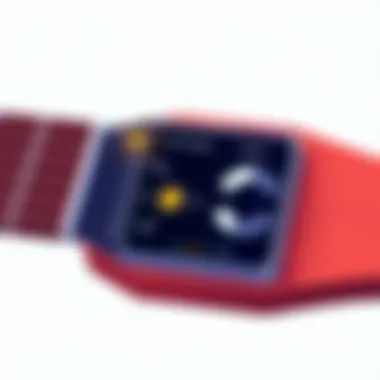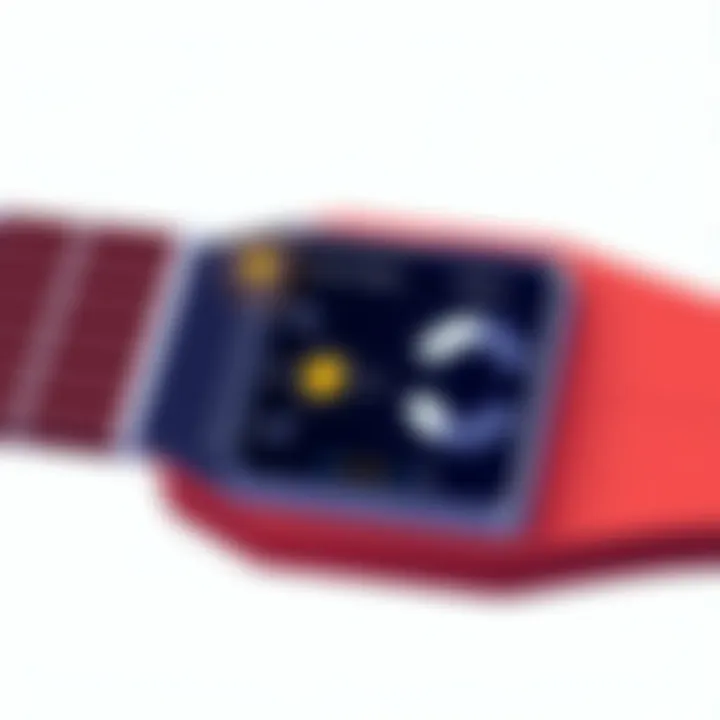Free Guitar Tuning Apps: Features and Comparisons


Product Overview
In the world of music, tuning a guitar properly is paramount. With the advent of technology, we now have an arsenal of free applications designed to make this mundane task easier. These applications can transform how both novice and seasoned guitarists approach tuning.
Key Features of Guitar Tuning Apps:
- Real-time Tuning: Many apps utilize microphone input to sense the pitch of each guitar string, providing immediate feedback.
- Visual Indicators: Color-coded graphics often signal whether a string is sharp or flat, aiding in quick adjustments.
- Tuning Modes: Most provide alternative tuning options, such as drop D or open G, expanding creative possibilities.
In essence, these free guitar tuning applications often serve as a reliable musical companion, eliminating the guesswork that often comes with manual tuning methods.
Performance and User Experience
After testing various guitar tuning apps, certain patterns emerged regarding performance. The interface plays a massive role in user satisfaction. Some apps, for instance, present a simple "tap to tune" layout that minimizes distractions. Others may offer a plethora of options that, while impressive, can overwhelm users.
Many users appreciate apps that feature corrective feedback, providing a gentle nudge towards the perfect pitch. The sound quality and accuracy of tuners can vary widely; thus, it’s insightful to read user reviews on platforms like Reddit to gauge the collective experience of other musicians.
Design and Build Quality
While discussing design, it’s essential to note how applications handle aesthetics. A sleek, appealing interface can often make the experience more enjoyable. Some applications utilize dark mode for reduced eye strain, while others boast vibrant themes that catch the eye.
The build quality in regards to applications relates to efficiency and responsiveness. Apps that load quickly and operate smoothly tend to gather more positive attention. Durability in this context may refer to the regular updates provided by developers to ensure optimal functionality with evolving smartphone technology.
Technology and Innovation
As technology marches on, innovative features keep coming into play in the realm of music applications. Some tuners now integrate machine learning to adapt to a user's unique guitar, which can be a game changer. Such technology can fine-tune the tuning experience, adjusting algorithms based on how your instrument resonates.
Additionally, certain applications are beginning to utilize augmented reality. Imagine pointing your phone's camera at your guitar while the app suggests tuning adjustments live, on-screen. The potential impact? Revolutionary.
Pricing and Value Proposition
The price point of free apps, naturally, makes them accessible to many. But how do they compare to premium options?
- Affordability: All the apps reviewed are free, making them a compelling starting point for beginners.
- Value Comparison: While professional-grade tuners might offer advanced features, the essential functionality found in free apps often suffices for everyday playing needs.
"In music, just as in life, the right tools can enhance your journey considerably."
For further exploration into guitar tuning apps, consider visiting Wikipedia or checking discussions on Facebook for user experiences. These resources can provide deeper insights into the features and functions that are most valued in the tuning process.
Prelims to Guitar Tuning
Guitar tuning may seem like a straightforward, almost trivial part of playing, yet it stands as one of the most fundamental elements in music. The difference between a properly tuned guitar and one that’s off even slightly can transform a sweet melody into a cacophony. Regular tuning not only ensures that a guitarist enjoys their down-time, but it also sets the stage for entire performances. Whether jamming alone or playing in a band, being in tune is paramount. Therefore, having a reliable method to achieve perfect tuning can enhance any guitarist's experience.
Understanding the Importance of Guitar Tuning
Firstly, guitar tuning is crucial because it affects the overall sound. An out-of-tune instrument can create frustration for the player and confusion for the audience. A guitar can be likened to a symphony; if one instrument is off-key, it disrupts the harmony.
Moreover, tuning helps develop one’s ear. By regularly tuning their instrument, beginners start to recognize what a properly tuned guitar sounds like. This can be an invaluable skill as they progress in their musical journey. The experience of trying to find the right note can serve as a stepping stone towards musical proficiency. When using tuning apps, this learning process can be drastically accelerated, guiding players more effectively than traditional methods.
In addition, tuning impacts the overall performance experience. A guitar that remains in tune holds the power to elevate the entire vibe of a performance. Whether it’s an intimate gathering or a grand concert, consistency in sound translates to confidence and enjoyment.
Traditional vs. Digital Tuning Methods
Across the years, guitarists have relied on various methods to keep their strings taut and harmonious. Traditional tuning has typically involved the use of tuning forks or simply tuning by ear with another instrument. While these methods have their place, they also can lead to inaccuracies if one isn’t well-versed in their sound.


On the flip side, the emergence of technology has ushered in a new age of tuning options. Digital tuners and, more recently, tuning apps have made the process not just easier, but more precise. No longer do guitarists need to have perfect pitch to tune their instrument; instead, they can lean on the technology in their pockets.
In this context, tuning apps come with various features that can simplify the process. They offer visual feedback on pitch and can often accommodate multiple tunings—something that can feel overwhelming when done traditionally. So how do these technologies stack up? Traditionalists might argue for the tactile experience of the tuner, while tech-savvy players appreciate the convenience and accuracy of apps. Ultimately, it seems the best of both worlds is available: understanding the roots of guitar tuning alongside the modern marvels that help achieve it.
In a realm that continuously evolves, knowledge about these differences is more than mere trivia. It empowers guitarists, helping them choose tools that align best with their style and needs.
The Role of Apps in Guitar Tuning
The emergence of smartphone technology has influenced many facets of daily life, and guitar tuning is no exception. While traditional methods of tuning a guitar—like using a pitch pipe or tuning fork—are still valued, the advent of tuning apps is a game changer. The role these apps play goes beyond just convenience; they serve as vital tools that empower musicians, simplifying the guitar tuning process and enhancing overall sound quality. With numerous applications available, ranging from basic tuners to advanced devices with multiple functionalities, guitarists can find their ideal aid tailored to individual needs.
Evolution of Tuning Technology
Tuning technology has experienced a radical transformation over the past few decades. Originally, musicians relied on their own pitch recognition skills and physical tools to achieve the correct tuning. Pitch pipes, which produce a reference note, or the classic tuning fork that emits a standardized pitch have been around for ages. However, these methods are not infallible and require a level of training and experience to master.
As technology progressed, electronic tuners entered the scene. These devices offered improved accuracy, often utilizing visual indicators to guide musicians in the tuning process. The advent of digital tuners introduced features such as chromatic tuning, which allows for the tuning of all twelve notes, rather than just the standard EADGBE of a guitar, enabling players to experiment with various tunings with ease.
Now, with smartphones becoming an integral part of music-making, tuning apps stand at the forefront of this evolution. Unlike their precursors, apps can combine multiple functionalities into one package, offering not just tuning capabilities but also metronomes, recording options, and even lessons—transforming a tuning device into a more comprehensive musical companion.
How Apps Simplify Tuning
For many guitarists, using a tuning app streamlines the tuning process significantly.
- User-friendly Interfaces: Most tuning applications come with intuitive designs that make it clear and straightforward for both novice and seasoned guitarists to use. The visual feedback offered by embeddable microphones in smart devices allows users to quickly assess their tuning accuracy with just a glance.
- Precision and Customization: Most apps boast high levels of accuracy, whether you’re tuning to standard, open, or even alternative tunings. Guitarists can often customize settings to fit specific needs, allowing for precise adjustments based on various playing styles or vocalists’ requirements.
- Real-time Feedback: Tuning apps often provide real-time feedback, allowing users to see how close they are to getting the desired pitch instantly. This instantaneous feedback accelerates the learning process for beginners, while even experienced players appreciate the time savings during a performance.
- Digital Chromatic Tuners: Many apps come equipped with a chromatic tuner, meaning the app can recognize all notes—not just the ones traditionally used on the guitar. This adaptability provides guitarists the freedom to explore myriad tunings easily.
In summary, the role of apps in guitar tuning cannot be overstated. They mark a step forward in musical technology, supporting musicians both in practice and on stage. As tuning evolves, these applications may very well become the standard for tuning among guitarists, reshaping how we perceive and achieve sound quality in our instruments.
Evaluating Free Tuning Apps
Evaluating free guitar tuning apps is a fundamental step for anyone looking to enhance their musical experience. With a plethora of options available in the digital marketplace, it’s vital to scrutinize and understand what each app brings to the table. These applications can be powerful tools that not only simplify the tuning process but also cater to various skill levels and stylistic needs. The right app can be the difference maker when it comes to achieving that perfect sound.
When assessing these apps, several specific elements and benefits come into play. First and foremost, a keen eye should be on user-friendliness. This ensures that even those who are just starting can navigate the app without feeling overwhelmed. Secondly, features such as different tuning modes for standard and alternate tunings can enhance the user experience. Furthermore, considering the real-time feedback some apps provide is crucial since it allows users to make adjustments on the fly rather than relying solely on their ear. Ultimately, evaluating tuning apps requires understanding both their functionality and their practical applications in real-world scenarios.
Criteria for Selection
When selecting a free guitar tuning app, there are several criteria that stand out. Here’s what to look for:
- Accuracy: The foremost aspect of any tuning app should be its accuracy. The app should help you achieve the exact pitch without any guesswork.
- User Interface: A clean, intuitive interface minimizes distractions and makes it easier to focus on tuning, particularly under pressure.
- Range of Tuning Options: An ideal app wouldn’t just offer standard tuning; it should also cater to various alternate tunings that many modern guitarists might employ.
- Calibration Features: Some apps allow you to calibrate the pitch reference to suit various instruments, which is essential for more nuanced performances.
- Offline Functionality: Having the ability to use the app without data or Wi-Fi availability can be particularly advantageous during live performances or in studio settings.
Evaluating these criteria can help prospective users better align their needs with what each app provides.
Compatibility with Various Devices
A crucial aspect of free tuning apps is their compatibility with a range of devices. Not every app works seamlessly on all operating systems or device types. Being sure that the chosen app will function on your specific platform—be it iOS, Android, or even web-based—can save time and frustration. Here are some considerations:
- Operating System: Ensure that the app runs smoothly on your current OS version. Some apps may have limitations based on outdated software.
- Device Type: Whether you’re using a smartphone, tablet, or a computer, the app should fit well within the device’s performance parameters without lag.
- Audio Input Quality: Compatibility with built-in microphones is another factor. Some devices have poorer audio quality than others, which might affect the app’s ability to accurately detect notes.
- Updates and Support: Regular updates indicate good app maintenance. Check whether the app developers provide timely updates to address compatibility issues or bugs.
Keeping these factors in mind will bolster your ability to select an app that functions beautifully with your setup and enhances your guitar tuning process significantly.
"Choosing the right guitar tuning app is like finding a good pair of shoes; it should fit just right and support your musical journey."
For more tips on guitar tuning and related resources, you may visit Wikipedia or check discussions on community sites like Reddit.
This meticulous approach to evaluating free guitar tuning apps ensures that users can find a tool that not only meets their technical requirements but also complements their unique style and preferences.


Popular Free Guitar Tuning Apps
In the vast world of music technology, guitar tuning apps hold a special place, especially for guitarists ranging from those just starting their musical journey to seasoned players. The convenience of accessing precise tuning on a smartphone is a game changer. This section highlights several popular free guitar tuning apps that have plus points in terms of functionality and user experience, making them invaluable tools for musicians across various skill levels.
App One: Features and Usability
Let's take a closer look at one notable app in the realm of guitar tuning – GuitarTuna. This app is highly clickable in the app store, and it’s no wonder why. With a simple interface, it caters to both novices and experts alike. GuitarTuna allows you to tune not just guitars, but also other stringed instruments. Users love its chromatic tuning feature that picks up notes quickly, resulting in a fast setup before practice. The metronome feature is an added bonus, helping players keep time while they play. Users have commented on how intuitive the design is, making it easy to jump straight into tuning without wading through complex menus.
App Two: User Reviews and Performance
Another strong contender is PitchLab, which has garnered attention for its visual tuning experience. Users often rave about the vibrant graphics that accompany its functionality. The app has a pitch-detection system that is reported to be reliable and accurate. While diving into the user reviews, one notices a common thread praising how it helps visualize their tuning on a color spectrum from red to green, allowing players to see their progress in real-time. However, a few users expressed concern about the occasional lag in response time. Therefore, while PitchLab stands out for its visual appeal, some might find it less effective in high-pressure situations when instant feedback is crucial.
App Three: Key Benefits and Drawbacks
Lastly, the app Cleartune deserves a mention as well. This tuner has a reputation for being exceptionally accurate. Users note that it works effectively in a variety of conditions, whether in a quiet room or a noisy environment, making it quite versatile. An appealing feature is its capability to tune other instruments, giving it a broad usability scope. Yet, the downside is that some users mention it can drain the battery quickly, leading to concerns for long sessions. Thus, while Cleartune is praised for its precision, users should be aware of its power consumption when out on a gig.
Ultimately, selecting an app can feel a bit like choosing between a rock and a hard place given the myriad of options. Each app comes packed with distinct features, and pinpointing the one that aligns best with a player's individual needs is crucial.
"In a world where tuning is just a tap away, the right app can make all the difference in performance and practice.
Comparative Analysis of Top Apps
The growing availability of free guitar tuning applications warrants a thoughtful evaluation of the top contenders on the market. Users seek not only functionality but also an intuitive experience that enhances their overall musical journey. In such an expansive sea of choices, understanding the comparative advantages and disadvantages of each app becomes essential.
By exploring aspects like user interface, additional features, and overall performance, guitarists can make informed decisions that align with their specific needs. This section aims to dissect critical elements that set these apps apart, ultimately guiding users toward the most suitable choice for their tuning endeavors.
Usability and Interface Design
Usability plays a monumental role in how effectively a tuning app can bridge the gap between novice and expert users. A clean and straightforward interface can make the difference between a seamless experience and one that feels clunky and frustrating. When diving into various apps, consider:
- Intuitive Navigation: Users should find it easy to access core features without sifting through unnecessary menus. An app that enables quick tuning changes will result in less time fumbling and more time playing.
- Visual Design: Aesthetics may seem secondary, but an attractive layout can enhance user engagement. Bright colors and clear fonts make information easy to digest, helping ensure that users have a pleasant tuning experience.
- Customization Options: Some individuals like to tinker with default settings, while others prefer an app that just works out of the box. The presence of customizable options can be a major selling point.
Thus, in a comparative analysis, look not solely at functionalities but at how friendliness of use can influence engagement and frequency of app usage.
Accuracy and Performance
Accuracy is the heart of any tuning application. Without reliable performance, even the most beautifully designed app falls flat. There are several layers to consider when evaluating accuracy and performance in these apps:
- Tuning Accuracy: Many apps boast their precision, but how do they truly perform? User reviews often spotlight inconsistencies based on various guitar types and playing environments. When testing an app, one should pay attention to how well it can discern pitches in challenging settings.
- Speed of Tuning: Time is of the essence, especially when musicians are tuning between songs. Users appreciate an app that locks onto a pitch quickly. Taking note of how fast tuning occurs—whether through visual feedback or sound—can inform choices effectively.
- Real-time Feedback: A pivotal aspect is how well the app provides real-time feedback during tuning sessions. The user should have clarity regarding whether they’re in tune or need adjustment. This function not only aids beginners but also serves seasoned players who can sometimes overlook fine-tuning nuances.
"The speed and accuracy of a tuning app can significantly enhance practice sessions, making the process more enjoyable and productive."
When assessing accuracy, checking online forums or communities, such as reddit.com, can unearth insights that pure marketing may gloss over. It’s imperative to gather nuanced user experiences that reflect real-world usage.
User Experience: Insights from Guitarists
In the world of guitar tuning, the user experience plays a crucial role in how well musicians can adjust their instruments to the perfect pitch. Understanding what resonates with different types of guitarists can help illuminate the effectiveness of various free tuning apps available today. From ease of use to specific features tailored to individual needs, the feedback from users—especially beginners and advanced players—provides a wealth of information that can guide future app developments and selections.
Feedback from Beginners
For novice guitarists, the tuning process can feel overwhelming. They may find themselves wrestling with the strings and frets, trying to figure out if they’re in tune or playing flat. This is where free guitar tuning apps shine. Many beginners appreciate the straightforward interface these applications often offer. Typically, they feature bright visuals and simple instructions that can swiftly guide someone with limited experience.
Users often mention a few key benefits:


- User-Friendly Interfaces: Beginners often seek clarity. Apps like Fender Tune or GuitarTuna feature large buttons and clear indicators, making it easy for newcomers to understand where to turn their tuning pegs.
- Instant Feedback: Many users enjoy the instant audio feedback provided by these apps. This allows beginners to hear how their adjustments sound in real-time. Little things like color-coded displays indicating sharp or flat notes help demystify the tuning process.
- Learning Tools: Some apps integrate basic guitar lessons alongside the tuning feature, making them a two-in-one deal. Beginners appreciate learning about the notes as they tune, absorbing valuable knowledge while they practice.
Beginners tend to share their journeys on platforms like reddit.com or facebook.com, often showcasing their favorite apps and what particularly helped them feel more comfortable with their instruments.
Advanced Users: A Different Perspective
On the flip side, experienced players have a different set of expectations. While advanced guitarists likely have a better handle on pitch and tuning sequences, they still look for precision and advanced functionalities in tuning apps. Here are some areas of concern that seasoned players frequently express:
- Precision Tuning: Advanced users often desire high precision, especially when playing in alternate tunings or composing music. Apps that allow for custom tuning profiles—like PT-1 or Cleartune—tend to get favorable feedback from this crowd.
- Integration with Other Gear: Many experienced players appreciate the ability to connect apps to other musical devices or software. For instance, a professional guitarist might want an app that plays nicely with their digital audio workstation (DAW) or other tuning tools they use in a studio setting.
- Advanced Features: Some guitarists look for features such as pitch calibration settings or tuning forks. Apps that offer these options may be viewed more favorably by this cohort, as they align with the complexity of advanced play styles.
Overall, the insights gathered from both beginner and advanced users highlight the diversity in expectations and experiences when tuning guitars with free apps. Each perspective informs the development of these apps and enriches the community of guitarists learning from one another.
"No matter where you're at in your guitar journey, the right tuning app can transform the way you play, allowing you to focus more on the music and less on the mechanics."
By synthesizing feedback from both ends of the spectrum, developers can create better tools that not only facilitate the tuning process but also contribute to the musicianship of players across skill levels.
Future Trends in Guitar Tuning Technology
As the music landscape continues to evolve, the methods for tuning guitars are no exception. The integration of technology into music has opened up a plethora of options that enhance precision, convenience, and user experience. This section will explore some promising trends that are shaping the future of guitar tuning, focusing on how these developments benefit musicians of all skill levels.
Integration with Other Music Apps
The future of guitar tuning isn’t standing still. One notable trend is the increasing integration of guitar tuning apps with other music applications. Musicians often rely on a suite of tools to compose, record, and share music. By connecting tuning apps with digital audio workstations (DAWs) or metronome applications, musicians can streamline their workflow significantly.
For instance, if a tuning app communicates seamlessly with a DAW like Ableton Live or Pro Tools, a guitarist can tune their instrument while simultaneously crafting or mixing tracks. This not only saves time but also enhances the overall creative process. Some apps are beginning to incorporate features that allow users to record their tuning settings, ensuring they can quickly revert to preferred tunings or settings anytime.
Integrating guitar tuning apps with other musical tools can lead to a more efficient and collaborative experience.
Moreover, many apps are rumored to start including social functionalities, allowing users to share their preferred tuning settings directly with others. Picture this: a guitarist struggles with a certain tuning and can instantly access suggestions from a global community of players. This level of interactivity could revolutionize how musicians approach tuning, bridging the gap between tuning, collaboration, and creativity.
Artificial Intelligence in Tuning Apps
Artificial Intelligence (AI) is not just for sci-fi movies anymore. It has begun playing a pivotal role in the development of tuning apps. The enhancement in machine learning algorithms means that tuning apps can now detect less common tunings and suggest adjustments with remarkable precision.
Imagine a scenario: you're trying to achieve an alternate tuning for a specific song and your app can analyze your playing and provide real-time feedback to help fine-tune the sound. This capability to instantly learn from a player's unique style and preferences makes AI a game-changer in guitar tuning.
Further, AI can help predict the necessary adjustments based on environmental factors, like room acoustics, or specific music genres. For example, tuning for bluegrass might differ from tuning for metal, and an AI-enhanced app could tailor its recommendations accordingly. As technology progresses, it’ll likely become more adept at understanding the nuances of different instruments and styles, making it invaluable to musicians.
The implementations of AI could also extend into personalization where apps can learn frequently used tunings by a player over time to suggest their preferred settings automatically. In this way, guitarists can spend less time fiddling with their gear and more time focused on what really matters—making music.
Closure
In wrapping up our exploration of free guitar tuning applications, it’s clear that these tools provide an accessible entry point for both novices and seasoned players alike. The advent of smartphone technology has radically altered how musicians approach tuning. With just a few taps on their devices, guitarists can achieve an accurate pitch, making the experience less tedious and more engaging.
Summarizing the Benefits of Using Free Tuning Apps
Free tuning apps bring several advantages to the table:
- Convenience: They allow musicians to tune anywhere, anytime, eliminating the need for bulky gear.
- Accuracy: Many apps utilize sophisticated algorithms that ensure precise tuning, often surpassing traditional tuners.
- Variety of Tunings: They often support various alternate tunings, which encourages creativity and experimentation.
- User-Friendly Interfaces: Most apps are designed to be intuitive, making them easy for beginners to navigate without much of a learning curve.
"The right tuning app can be your best friend, whether you're jamming in a garage or on a stage."
This plethora of options dismantles the barriers that many beginners encounter and fosters an inviting landscape for learning.
Final Recommendations for Guitarists
When choosing a guitar tuning app, consider the following aspects to find the best fit for your needs:
- Device Compatibility: Ensure that the app can seamlessly work with your smartphone or tablet, whether it's iOS or Android.
- User Reviews: Take the time to read what other musicians say about app reliability and performance. Platforms like Reddit or specialized forums can provide insights that are often more candid than official reviews.
- Additional Features: Some apps come with metronomes, chord libraries, and learning tools. Think about what extra features might enhance your playing experience.



